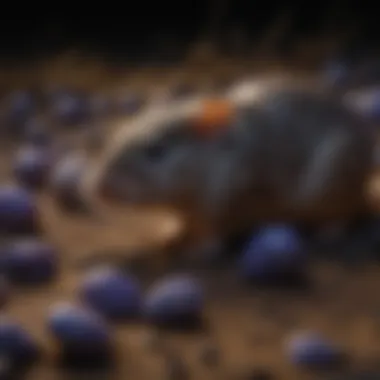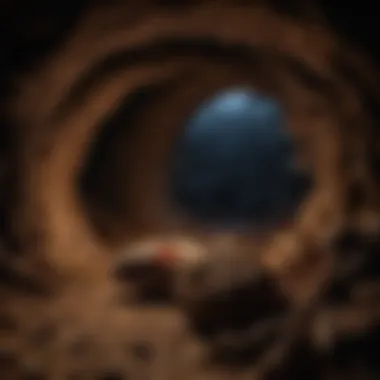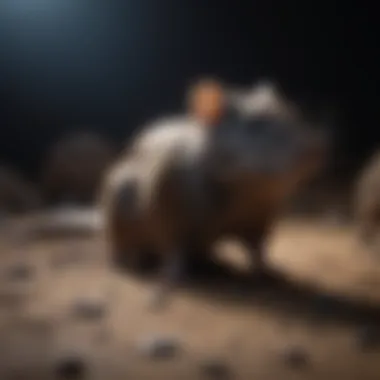Unlocking the Power of Black Light Technology for Rodent Detection: A Comprehensive Exploration


Black light technology offers an effective method for detecting rodents, delving into the intricacies of how this technology works and its applications in pest control. This guide aims to provide valuable insights for individuals seeking advanced pest control strategies.
Unpacking Black Light Detection
Understanding the Science
Black light, also known as ultraviolet light, operates beyond the visible spectrum. When rodents come into contact with ultraviolet light, fluorescence occurs, making their presence detectable under the black light. This scientific process lies at the core of utilizing this technology for rodent detection.
Implementing Black Light for Rodent Detection
Methodology
To effectively utilize black light for rodent detection, thorough understanding of where and how to use the light source is vital. Identifying areas where rodents frequent and strategically placing black lights can maximize detection rates and enhance pest control efforts.
Key Considerations
Benefits of Black Light
Black light technology offers a non-invasive and efficient way to detect rodents. Unlike traditional methods that may disrupt rodent behavior, black light allows for discreet monitoring without causing disturbances. As such, it is a valuable tool in comprehensive pest management strategies.
Synthesizing Information for Effective Pest Control
Integrating Black Light Technology
By incorporating black light technology into existing pest control measures, individuals can enhance their ability to detect and address rodent infestations effectively. This synthesis of traditional and advanced methods can provide a holistic approach to pest management, ensuring thorough monitoring and control.
Additional Sections (optional, if applicable)
Rodent Detection Techniques


- Black Light vs. Traditional Methods
- Optimizing Black Light Setup
- Interpreting Black Light Findings
Advanced Pest Control Strategies
- Integrating Technology for Enhanced Detection
- Sustainable Pest Control Solutions
- Monitoring and Preventive Measures
Introduction
Understanding Black Light Technology
Definition of Black Light
The Definition of Black Light encapsulates the essence of a specific type of light that appears invisible to the naked eye but illuminates certain materials under its glow. This characteristic makes Black Light a commendable choice for rodent detection, as it unveils hidden traces of pest activity that may go unnoticed otherwise. The unique capability of Black Light to reveal otherwise unseen details is a substantial advantage in identifying rodent presence with precision.
How Black Light Works
Understanding How Black Light Works delves into the science behind the emission of ultraviolet (UV) light within the electromagnetic spectrum. This illumination causes certain substances, including rodent urine, to fluoresce and emit light visible under black light. The ability of black light to make specific substances glow facilitates efficient identification of rodent trails, burrows, and other indicators of pest activity.
Benefits of Black Light in Pest Detection
The Benefits of Black Light in Pest Detection range from heightened visibility of rodent markings to enhanced detection of hard-to-spot areas where pests may reside. By relying on black light technology, individuals can pinpoint elusive rodent burrows, thereby improving the accuracy of rodent detection efforts. Uncovering these hidden traces enables swift and targeted pest control measures to alleviate rodent infestations effectively.
Rodent Detection Challenges
Common Areas of Rodent Infestation
Exploring Common Areas of Rodent Infestation sheds light on the typical locations where rodents seek shelter and sustenance. By understanding these common infestation sites, individuals can proactively inspect and fortify vulnerable entry points, mitigating the risks of rodent intrusion. Recognizing these areas is instrumental in implementing preemptive pest control measures to deter rodent infestations.
Signs of Rodent Presence
Recognizing Signs of Rodent Presence is crucial in identifying rodent activity before it escalates. From gnawed objects to droppings and tracks, these signs serve as valuable indicators of rodent infestations. Utilizing black light technology to illuminate and analyze these signs can enhance the efficiency of rodent detection efforts and facilitate prompt intervention to address pest issues.


Limitations of Conventional Detection Methods
Acknowledging the Limitations of Conventional Detection Methods underscores the challenges inherent in relying solely on traditional pest detection techniques. Conventional methods may overlook subtle signs of rodent presence that are visible only under black light. By addressing these limitations and integrating black light technology into pest control protocols, individuals can significantly improve the efficacy of their rodent detection processes.
Benefits of Using Black Light for Rodent Detection
Black light technology revolutionizes pest control by offering enhanced visibility of rodent activity, surpassing conventional methods. This article explores the significance of implementing black light for rodent detection, shedding light on its unique advantages and considerations.
Enhanced Visibility of Urine Trails
Why Urine Trails Glow Under Black Light
Urine trails emitted by rodents exhibit a fluorescent glow under black light due to the presence of phosphors in the urine, reacting to the UV light. This characteristic makes it easier to detect rodent presence even in obscured areas, facilitating efficient pest management strategies. The ability to discern these trails with precision contributes significantly to the effectiveness of rodent detection methods employed when utilizing black light technology.
Locating Hard-to-Find Rodent Burrows
Locating rodent burrows can be a challenging task, especially in complex environments. However, with the aid of black light, these elusive burrows become more conspicuous as the UV light exposes their presence. This feature enables pest control professionals to pinpoint rodent hideouts accurately, enhancing the efficacy of pest eradication efforts. Despite its advantages, careful consideration of potential limitations in certain environments is necessary to optimize the use of this technique in rodent detection applications.
Identification of Rodent Entry Points
Tracing Gnawed Areas
Tracing gnawed areas with black light illuminates the pathways taken by rodents, highlighting the extent of the infestation. By visually mapping these areas, property owners can implement targeted preventive measures to fortify vulnerable entry points, thwarting rodent intrusion effectively. The distinct advantage of this method lies in its precision, allowing for a proactive approach in pest management.
Revealing Pathways for Pest Entry
Black light unveils concealed pathways that rodents exploit for entry into properties, facilitating the identification of ingress points. Understanding these pathways enables individuals to fortify vulnerable areas effectively, reducing the risk of recurrent infestations. While this method offers valuable insights into rodent behavior, careful assessment of structural vulnerabilities is pivotal to fortifying entry points adequately.
Efficient Monitoring of Rodent Activity


Surveillance
The capability for continuous surveillance afforded by black light technology allows for round-the-clock monitoring of rodent activity. This persistent vigilance ensures that any signs of rodent presence are promptly detected, enabling proactive pest management strategies. Integrating 247 surveillance enhances the overall efficacy of rodent control measures, providing a comprehensive overview of pest activity patterns within the monitored area.
Tracking Rodent Movements
Tracking rodent movements via black light facilitates the analysis of their behavior and preferred pathways. By discerning these patterns, pest control professionals can devise targeted strategies to deter rodents effectively. The detailed insights gained through tracking rodent movements support the development of tailored pest control plans, optimizing the mitigation of rodent infestations efficiently while minimizing environmental impact.
Application of Black Light in Rodent Control
In this comprehensive guide on utilizing black light technology for rodent detection, the application of black light in rodent control plays a crucial role. The utilization of black light technology is essential for identifying rodent presence and implementing efficient pest control strategies. By incorporating black light into rodent control measures, individuals can enhance their abilities to detect, monitor, and mitigate rodent infestations effectively. The methodical application of black light in rodent control ensures thorough inspection, precise identification of entry points, and vigilant monitoring of rodent activity, fostering a proactive approach to pest management.
In Residential Settings
- Inspection of Living Spaces: The inspection of living spaces using black light technology is a fundamental aspect of rodent control in residential settings. By conducting thorough inspections of living areas with black light, individuals can detect hidden traces of rodent activity, such as urine trails and gnawed areas, that are typically invisible to the naked eye. This meticulous inspection process enables homeowners to pinpoint the exact locations of rodent infestation, facilitating targeted and effective pest control measures.
- Preventing Infestations: Preventing infestations through the application of black light technology is a proactive approach to maintaining a pest-free environment in residential settings. By identifying and sealing off potential entry points highlighted by black light inspection, individuals can fortify their homes against rodent intrusion and minimize the risk of infestation. This preventive strategy not only safeguards the residential property but also ensures the health and safety of its occupants by mitigating the spread of diseases carried by rodents.
In Commercial Establishments
- Ensuring Food Safety: Ensuring food safety through the implementation of black light technology is paramount in commercial establishments. By utilizing black light to detect rodent presence and activity in food storage areas, kitchens, and dining spaces, businesses can uphold stringent hygiene standards and prevent contamination of food products. The use of black light for monitoring rodent activity helps commercial enterprises adhere to regulatory requirements and maintain the trust and loyalty of their customers by demonstrating a commitment to food safety.
- Maintaining Hygienic Standards: Maintaining hygienic standards through the integration of black light technology is essential for sustaining a clean and sanitary environment in commercial settings. By incorporating black light inspections into regular hygiene protocols, businesses can identify and address potential pest issues promptly, ensuring compliance with health and safety regulations. This proactive approach not only safeguards the reputation and credibility of commercial establishments but also fosters a safe and hygienic atmosphere for employees and customers alike.
Choosing the Right Black Light Equipment
Choosing the right black light equipment is a crucial aspect when it comes to effective rodent detection using this technology. In this article, we will delve into the specific elements, benefits, and considerations of selecting the appropriate black light equipment. The key to successful pest control lies in the quality and functionality of the equipment utilized. By understanding the importance of choosing the right tools, individuals can enhance their pest detection capabilities significantly.
Factors to Consider
UV Wavelength
The UV wavelength plays a pivotal role in achieving optimal results in rodent detection. Its ability to highlight specific substances like rodent urine makes it a critical factor in choosing black light equipment. The key characteristic of UV wavelength is its ability to cause certain materials to fluoresce, aiding in the identification of rodent presence. This feature is immensely beneficial as it allows for the precise location of urine trails and other indicators of rodent activity. While UV wavelength enhances detection accuracy, it is important to note that prolonged exposure to UV light can have potential disadvantages, such as eye strain or skin damage. Balancing its advantages and disadvantages is essential for utilizing UV wavelength effectively.
Portability and Durability
Portability and durability are essential considerations when selecting black light equipment for rodent detection. The ease of carrying the device around various locations ensures thorough inspection of potential infestation sites. Moreover, durable equipment can withstand rugged conditions, ensuring longevity and consistent performance. The key characteristic of portability lies in its ability to facilitate quick and efficient scanning of different areas without restrictions. Durability guarantees that the equipment remains functional even in challenging environments, providing reliable results when detecting rodent activity. However, portability may sometimes compromise certain features, while durability could lead to increased weight or bulkiness. Understanding these trade-offs is vital in choosing the most suitable equipment.
Battery Life and Recharge Options
Battery life and recharge options significantly impact the usability and effectiveness of black light equipment for rodent detection. A prolonged battery life ensures uninterrupted operation during thorough inspections, preventing disruptions in pest monitoring activities. Recharge options offer flexibility and cost-efficiency by reducing the need for constantly replacing batteries. The key characteristic of battery life is its direct influence on the duration of rodent detection procedures, affecting the overall efficiency of pest control measures. Recharge options provide convenience and sustainability, minimizing environmental impact through the reuse of rechargeable batteries. However, a shorter battery life or limited recharge cycles may diminish equipment usability, requiring frequent charging intervals. Balancing battery life and recharge options is essential for maximizing the operational capabilities of black light equipment.







